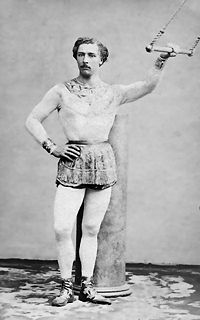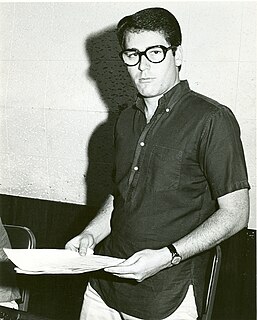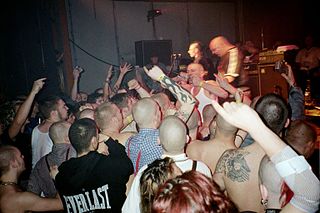
Punk fashion is the clothing, hairstyles, cosmetics, jewellery, and body modifications of the punk subculture. Punk fashion varies widely, ranging from Vivienne Westwood designs to styles modeled on bands like The Exploited to the dressed-down look of North American hardcore. The distinct social dress of other subcultures and art movements, including glam rock, skinheads, rude boys, greasers, and mods have influenced punk fashion. Punk fashion has likewise influenced the styles of these groups, as well as those of popular culture. Many punks use clothing as a way of making a statement.

A leotard is a unisex skin-tight one-piece garment that covers the body from the crotch to the shoulder. The garment was first made famous by the French acrobatic performer Jules Léotard (1838–1870). There are sleeveless, short-sleeved and long-sleeved leotards. A variation is the unitard, which also covers the legs.
FUBU is an American hip hop apparel company. It includes casual wear, sports wear, a suit collection, eyewear, belts, and shoes.

Levi Strauss & Co. is a privately held American clothing company known worldwide for its Levi's brand of denim jeans. It was founded in May 1853 when German immigrant Levi Strauss came from Buttenheim, Bavaria, to San Francisco, California to open a west coast branch of his brothers' New York dry goods business. Today's Levi's are made overseas, and there is only one line of jeans made in the US, in Greensboro, NC. The company's corporate headquarters is located in the Levi's Plaza in San Francisco.
Bell-bottoms are a style of trousers that become wider from the knees downward, forming a bell-like shape of the trouser leg.

Winklepickers, or winkle pickers, are a style of shoe or boot worn from the 1950s onward by British rock and roll fans. The feature that gives both the boot and shoe their name is the very sharp and long pointed toe, reminiscent of medieval footwear and approximately the same as the long pointed toes on some women's high-fashion shoes and boots in the late 2000s.
The casual subculture is a subsection of football culture that is typified by hooliganism and the wearing of expensive designer clothing. The subculture originated in the United Kingdom in the early 1980s when many hooligans started wearing designer clothing labels and expensive sportswear such as Stone Island, CP Company, L'alpina, Lacoste, Sergio Tacchini, Fila and Ellesse in order to avoid the attention of police and to intimidate rivals. They did not wear club colours, so it was allegedly easier to infiltrate rival groups and to enter pubs. Some casuals have worn clothing items similar to those worn by mods. Casuals have been portrayed in films and television programmes such as ID, The Firm and The Football Factory.
Guess is an American clothing brand and retailer. In addition to clothing for both men and women, Guess markets other fashion accessories such as watches, jewelry, perfumes, and shoes.

Jack Walter Keller was an American composer, songwriter and record producer. He co-wrote, with Howard Greenfield and others, several pop hits in the late 1950s and early 1960s, including "Just Between You and Me", "Everybody's Somebody's Fool", "My Heart Has a Mind of Its Own", "Venus in Blue Jeans" and "Run to Him". He also wrote the theme songs for TV series including Bewitched and Gidget, and later worked in Los Angeles – where he wrote for, and produced, The Monkees – and in Nashville.

A sleeveless shirt is a shirt manufactured without sleeves, or whose sleeves have been cut off. Sleeveless shirts are worn by people of any gender, depending on the style. They are used as undershirts, or worn by athletes in sports such as track and field and triathlon.

For most of the decade, 1990s fashion in Europe, Oceania, Asia, and America was defined by a return to minimalist fashion in contrast to the more elaborate and flashy trends of the 1980s. One notable shift in the western world was the mainstream adoption of tattoos, body piercings aside from ear piercing and to a much lesser extent, other forms of body modification such as branding.

1980s fashion in Britain, America, Europe and Australia had heavy emphasis on expensive clothes and fashion accessories. Apparel tended to be very bright and vivid in appearance. Women expressed an image of wealth and success through shiny costume jewelry, such as large faux-gold earrings, pearl necklaces, and clothing covered with sequins and diamonds. Punk fashion began as a reaction against both the hippie movement of the past decades and the materialist values of the current decade. The first half of the decade was relatively tame in comparison to the second half, which is when the iconic 1980s color scheme had come into popularity.

Lucky Brand Jeans is an American denim company founded in Vernon, California in 1990 by Gene Montesano and Barry Perlman. Lucky also produces other apparel, including activewear, outerwear, T-shirts, and professional attire. In December 2013, Leonard Green & Partners acquired Lucky Brand Jeans for $225 million from Fifth & Pacific Companies.

2000s fashion is often described as being a global mash up, where trends saw the fusion of previous vintage styles, global and ethnic clothing, as well as the fashions of numerous music-based subcultures. Hip-hop fashion generally was the most popular among young people of both sexes, followed by the retro inspired indie look later in the decade.
Castro clone is LGBT slang for a homosexual man who appeared in dress and style as an idealized working-class man. The term and image grew out of the heavily gay-populated Castro neighborhood in San Francisco during the late 1970s, when the modern LGBT rights movement, sparked by the 1969 Stonewall riots in New York City and the Summer of Love, gave rise to an urban community. The first recorded usage of the term is from Arthur Evans's "Red Queen Broadsides", a series of posters he wheatpasted around the Castro at the time. The look was most common from roughly the mid-1970s to around the mid-1980s. The Castro style regained popularity in the first decade of the 21st century, particularly among LGBT hipsters.

The 1960s featured a number of diverse trends. It was a decade that broke many fashion traditions, mirroring social movements during the time. Around the middle of the decade, fashions arising from small pockets of young people in a few urban centres received large amounts of media publicity, and began to heavily influence both the haute couture of elite designers and the mass-market manufacturers. Examples include the mini skirt, culottes, go-go boots, and more experimental fashions, less often seen on the street, such as box-shaped PVC dresses and other PVC clothes.

Fashion in the 1970s was about individuality. In the early 1970s, Vogue proclaimed "There are no rules in the fashion game now" due to overproduction flooding the market with cheap synthetic clothing. Common items included mini skirts, bell-bottoms popularized by hippies, vintage clothing from the 1950s and earlier, and the androgynous glam rock and disco styles that introduced platform shoes, bright colors, glitter, and satin.

Peter Golding created the first "designer jean" in 1970, opened his clothing store ACE on London's King's Road Chelsea in 1974 and created the world's first stretch denim jean in 1978. He was the first fashion designer to be invited to join what is now known as the Chartered Society of Designers, and in 2004 was invited by The Queen to Buckingham Palace in recognition of his contribution to British design.

Merc Clothing is a United Kingdom-based clothing company which specialises in the production of shirts, trousers, suits, parkas, harrington jackets, shoes and accessories for men and women. Although the brand originally focused on the mod and skinhead styles, they have adapted to target a wider clientele. They also carry a more casual range of jeans and T-shirts. The brand occasionally incorporates the Royal Air Force roundel in its designs. Merc Clothing is a privately owned company.

















